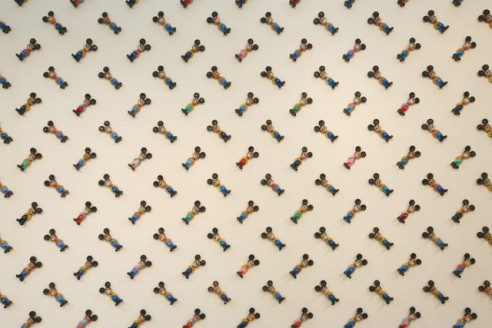
Serbian Pavilion
55th International Art Exhibition – La Biennale di Venezia
Vladimir Peric and Miloš Tomic
Nothing Between Us
June 1st – November 24th 2013
SERBIAN PAVILION AT THE 55TH VENICE BIENNALE
Artists: Vladimir Peric and Miloš Tomic
Exhibition title: Nothing Between Us
Commissioner: Maja Ciric
Venue: Giardini della Biennale
1 June – 24 November 2013
Preview days: 29, 30 and 31 May 2013
The project Nothing Between Us comprises the works of two artists/researchers/collectors, Vladimir Peric and Miloš Tomic, who have developed a particular way to present some segments of the collections they have amassed over the years through obsessive accumulation of various used objects (especially childhood memorabilia, in Peric’s case, and sounds generated using unconventional sound-producing tools/devices, in Tomic’s). Peric’s installations in the Pavilion form an ensemble that has been very precisely conceived and ordered expressly for the space of the Pavilion. It includes various portions of several of his collections, but mainly consists of the Museum of Childhood. Tomic’s works are instead video diaries of his research on a broad spectrum of spontaneous, unconventional, amateurish, unsophisticated, innocently unpretentious and even naively arrogant attempts to make some kind of music outside the accepted cannons of professional music production. His aim was to experiment with complex forms of music and video based precisely on such premises.
As for Peric, the high degree of order and the utmost precision he imparts to the structure of his works is however not taxonomical: he does not present his Museum collections in a museological fashion. On the contrary, he reshapes their content into allegorical assemblages that tell stories of the places and settings whence they were gathered, and recount the now lost times when their elements had some practical function in the lives of their former owners. At the same time, he takes issue with present times, as well as the position artists assume with their works at the exhibition. He integrates these collected objects into minimalist installations, whose elements are ordered according to repetitive schemata, making the individual features of those elements disappear in the play of optical illusions.
Departing from any stable established order, the seemingly out-of-control nature of Miloš Tomic's work (diametrically opposed to Peric’s) nevertheless presents underlying formal aspects. Tomic constantly shifts the application grounds of professional skills and knowledge, in order to enable various unplanned, unexpected, and even unwanted things to appear, requiring the invention of new work strategies and methods. His diaries have no aim to professionally document or adequately represent processes or situations, people or events, or the course of his research on anything and everything that could be counted as music. All such documentary recordings of utterly anarchistic content - evoking the traditions of anti-art predating the gaze of the onlooker - are just starting points and authentically raw materials that infuse the project with particular vivacity. For the structure of the final products these recordings have been significantly altered by the form into which they have been converted, enhanced by multiple visual and musical layers, made with high-level media sophistication and according to controlled production standards.
An insistence on experimentation, as well as working with found materials (both objects and situations) link these two artists, who maintain “there is nothing between us”, that their works are heterogeneous and mutually independent. However, it is precisely the relation between these two bodies of work that creates a “dialectical tensions between the poles of disorder and order”.
-
In his essay "Unpacking My Library" Walter Benjamin writes about the life of a collector as consisting of "a dialectical tension between the poles of disorder and order". Serbian Pavilion's project titled Nothing between Us features works by two artists/researchers/collectors, whose obsessions (Vladimir Peric's with childhood memorabilia and Miloš Tomic's with contingent sounds and sound production devices) have driven their practices towards acquiring specific forms of presenting their collections.The installations by Vladimir Peric, are made to incorporate items from the collections of his Museum of Childhood, extremely precise arrangement that create a seductively melancholic atmosphere. The works of Miloš Tomic video diaries of his research delve into deskilled music practices and social relations built around them. He celebrates this anarchic and ecstatic format and celebrates their ludic potential. By demonstrating two polemic types of collecting they exteriorize the dialectical tension Benjamin wrote about, from individual projects to the relation between the projects in the space of the Pavilion.
-
About Vladimir Peric
Only in the late 2000s did Vladimir Peric begin to author artworks under his given name; for ten years, he exhibited under the pseudonym “Talent” and as a member of the group “Talent Factory.” In his exhibitions, he frequently presents objects he has gathered, which have been discarded by others, without modifying them. He works with quotidian artifacts and personal paraphernalia, like photographs found in flea markets in Serbia. One of his best-known and most monumental works is the ongoing project called “Museum of Childhood” (begun 2006)—the work is comprised of toys, tools, and objects popular in households in the former Yugoslavia during his childhood. “Museum of Childhood” is also the first work Peric produced without using his pseudonyms.
About Miloš Tomic
Miloš Tomic is a multimedia artist whose projects span film, photography, collages, and sculpture. Tomic studied directing and then animation—experiences that continue to influence his practice. His subjects are either comprised of or preoccupied with disposable or disposed objects. In fact, his doctoral thesis was titled “Preciousness of discarded objects, i.e. trash as the material for film, photography…” His object-based works are modified quotidian objects, like shoes sewn shut or brushes with thorns instead of bristles. Tomic also has a category of sculpture called “Pearls” which, as he describes, are “to be understood as things that are precious, wrongly forgotten or lost somewhere, but now found.”
Press Office:
Milena Gnjatovic:
gnjatovic.milena@gmail.com
Nataša Lazic:
natasa@msub.org.rs


